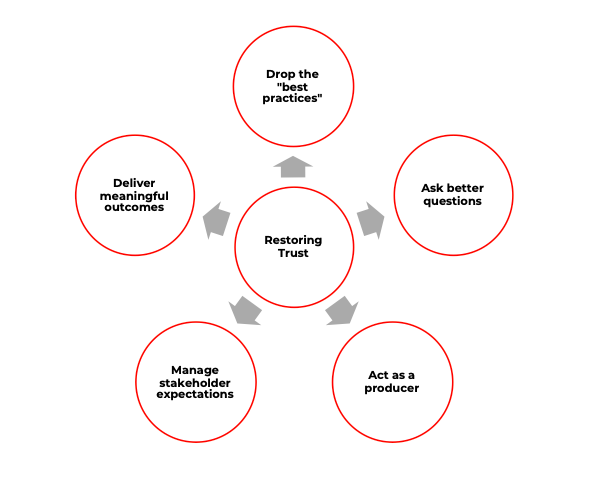Restoring Trust in Marketing

Marketing may have a seat at the table in business strategy discussions, but most of the time, it seems to have a whoopie cushion on it.
However, it’s not the fault of individual marketers. Almost without exception, marketers are thoughtful, creative leaders and contributors. They care deeply about their business's outcomes and customers. Nevertheless, marketing as a business function struggles to build credibility.
However, thought leadership initiatives can help marketers repair their credibility and restore trust—with one crucial caveat. Initiatives must be executed well, from concept to publication.
The Butt of the Joke
A quick look at recent history shows how we got to this point. Marketing alignment is not a new problem. One notorious survey released by The Fournaise Marketing Group in 2012 found massive—and, sadly, unsurprising—disconnects between marketing and the business:
- 80% of CEOs admitted they didn’t trust the work done by marketers.
- 80% of CEOs believed marketers were disconnected from companies' short-, medium- and long-term realities.
- 75% of CEOs said marketers misunderstand concepts like results, ROI, and performance.
- 71% of B2B CEOs believed that marketers focused too much on the latest marketing technologies (such as marketing automation, lead management, and CRM) at the expense of delivering demand.
More than ten years later, little has changed. A 2023 survey by McKinsey & Company found:
- CEOs are concerned that marketing metrics tie to business impact less than 60 percent of the time.
- More than two-thirds of CEOs said there were two or more leaders in their companies with marketing-related activities in their purview.
- Only 22% of marketing chiefs say their jobs are well-defined and understood by other C-suite executives.
But Why?
Three forces have converged to get us to where we are today.
First, marketing has become increasingly specialized and sub-specialized. Few marketers have education or professional backgrounds close to their business's core activities. This gap becomes an increasing liability, especially in complex or technical B2B companies.
Second, marketing channels and technologies have proliferated. The number of martech solutions has increased by a factor of more than 30 times to over 11,000. These tools generate an enormous amount of data exhaust that seems to quantify marketing impact.
Third, marketers have overcompensated for their anxieties about business value. They have doubled down on more metrics, more KPIs, and more meaningless numbers as a way to demonstrate just anything that could look like a justification for their existence.
Let’s face it: chasing numbers like puppies on a wet floor is not a good way to look dignified.
Five Steps to Restoring Trust
Marketing leaders have every right to be depressed and frustrated. Less than half of CMOs remain in their roles for more than three years. Nearly three-quarters of marketers do not see their work as highly meaningful (4 or 5 on a scale of 5).
But there is hope. Marketers can take five radical steps to restore trust by integrating better with the business.
(Keep in mind, I’m referring to B2B marketing here)

- Drop the “best practices” — Leaders and stakeholders do not care about ideas marketers have picked up in their reading or at conferences. And they don’t have much faith in “we’ve always done it that way.” Labeling an approach as a “best practice” is often an unfortunate indicator that it’s part of the same old toolkit. Instead, focus on clear plans that demonstrably impact the business in a way you can explain.
- Ask better questions — I’ve been in many meetings where marketing leaders ask their peers in product or sales teams what they want. It immediately shifts the conversation to order-taking mode. And it erodes future credibility. Instead, focus on questions about what they want to accomplish, what their goals are, and why they have those goals. Learn to probe to understand the choices they have made, the challenges they face, and the outcomes they seek. Take ownership of the marketing strategy and tactics that will best enable their success.
- Act as a producer — The film industry provides a viable model for what a marketing function can and should do. In film, producers handle planning, coordination, casting, directing, editing, finances, marketing, and distribution. They find promising concepts, coordinate the resources needed to develop them, and then oversee a finished film's promotion, distribution, and marketing. They bring talent together rather than trying to fill the shoes of that talent. Marketers can do the same by bringing together subject matter experts and creative talent to create marketing assets and then own the distribution of those assets to the optimal audiences.
- Manage stakeholder expectations — Marketers often try to set expectations but fail because they use industry jargon and vanity metrics instead of speaking the language of business impact. Marketing-speak isolates stakeholders and sets the stage for disappointment. Instead, translate programs into tangible objectives in terms your business peers understand. Work with them on their terms and in their language and hold regular check-ins to validate project progress.
- Deliver meaningful outcomes — Because marketing has lost so much trust, many business stakeholders can’t offer a clear picture of what they actually want. Sales may ask for “qualified leads,” but what they want could be as simple as having more meaningful conversations with prospects to increase the speed and number of closed deals. Instead of delivering outcomes that mean nothing (such as how many people filled out a web form), consider outcomes such as impacting the way decision-makers think about their challenges and ultimately make their buying decisions.
How Thought Leadership Helps
Thought leadership, if executed successfully, demonstrates marketing's strategic value. In addition to producing high-quality, high-impact work, it presents an opportunity for marketers to lead, shine a spotlight on their business acumen, and rebuild credibility by collaborating with stakeholders. It also forces alignment between marketing and the business on customer challenges and developing a shared vision for how a company’s solutions address real-world client needs. In other words, it creates an ideal scenario for putting the five steps for restoring trust into practice.
However, thought leadership is not a magic solution. Projects often scramble due to misaligned expectations, unclear goals, and poor planning if they fall back into familiar territory.
Here’s what can go wrong. Marketers may fixate on traditional “best practice” tactics like whitepapers instead of truly distinctive perspectives. They can stray into overly promotional messaging that damages credibility without asking for sufficiently substantive involvement from subject matter experts. Or, if marketing fails to act as a producer by managing development and distributing assets, these projects can leave stakeholders questioning the rationale behind the entire initiative and the value of marketing itself.
Nevertheless, thought leadership requires a shared understanding of the issues and trends that matter to a company’s clients and sheds an intense light on how the company differentiates its solutions. As a result, it may be marketers’ best and only way to win back a safe and welcome seat at the table.
Three Grace Notes
"At the basis of the contemporary obsessions with so-called ‘Big Data’ lies the double ontological assumption that: (1) the language of information technology is capable of grasping the whole of the existent; (2) more extremely, the whole of the existent coincides with the reach of the language of information technology." — Federico Campagna, Technic and Magic
"When we have success, we gain a reputation as a “go to” person. We become “good old [insert name],” who is always there when you need him, and we are presented with increased options and opportunities...The effect of our success has been to undermine the very clarity that led to our success in the first place." — Greg McKeown, Essentialism
"There’s only one way to get through the fog of fear, and that’s to transform it into the clarity of exhilaration." — Gay Hendricks, The Big Leap: Conquer Your Hidden Fear and Take Life to the Next Level
Note: The links above are affiliate links. I'm using them in lieu of paid subscription tiers or digital tip jars. Seems like a much more graceful way to generate financial support while sharing more thinking and writing that can guide thought leadership.
